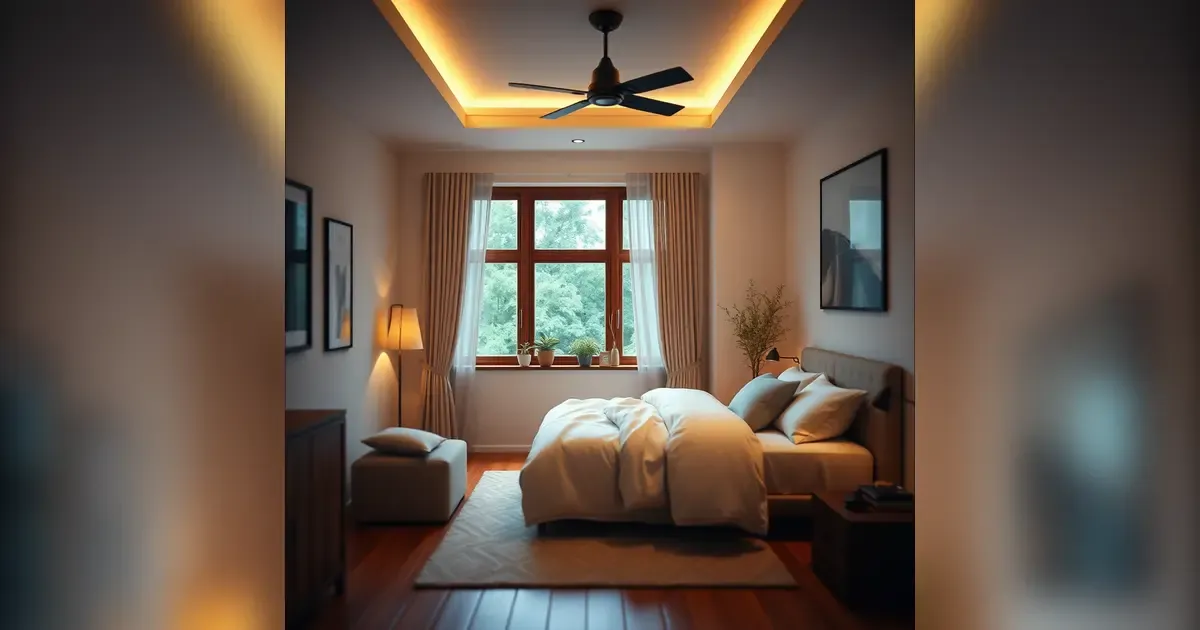The article will dwell on different aspects of bedroom design in terms of creating a peaceful environment that elicits comfort and peace.
A bedroom is never just a place to sleep; rather, it is a personal den and hideout from the demanding day. Turning this into a haven of tranquility is important for rest and rejuvenation to be achieved in your bedroom. The article will dwell on different aspects of bedroom design in terms of creating a peaceful environment that elicits comfort and peace. Here are tips and Ideas that will help you create a relaxing bedroom.
Choose Calming Colors
Color dances with mood and relaxation, especially when one has soft and soothing tones like gentle blues, muted greens, and neutrals. The blues tone in the wall serves as the background with soothing tones. Green tones, being natural-like, can also provide tranquility and renewal. Neutral colors like beige and gray form a versatile base that is easily complemented with various accents. Expand that to the curtains and bedding for a cohesive, soothing feel.
Choose Comfortable Bedding
Comfortable bedding affects sleep quality and comfort. You need high-quality sheets, plush pillows, and a supportive mattress. Materials to be used include cotton, linen, or bamboo because of their breathability and softness. A well-supporting mattress will promote your body's rest. In choosing pillows, base them on your sleeping position, as they give support to your neck and head. Also, invest in a good comforter or duvet as it adds comfort for a restful night's sleep.
Use The Right Light
Soft, warm lighting invites relaxation. Consider using lamps that allow adjustment to brightness or add string lights to provide a soft glow. Dimmer switches installed on overhead lights allow the user to adjust the lighting to their liking according to the time of day or specific activity. Light-filtering curtains can help regulate natural light. The soft, comforting light during the day or early evening assures a gentle wake-up experience.
Maintain a Clutter-Free Space
A clean room is a quiet room. Clean up clutter from your bedroom regularly. Utilize storage devices such as baskets, bins, and drawers to keep items out of sight. Use, Multi-functional furniture such as beds with drawers to minimize clutter. Place everything where it is supposed to be so the atmosphere will remain serene and quiet to reduce stress.
Add Personal Touches
To make a bedroom yours, add a personal touch of things that remind you of memories or happy times. You may also frame photos, hang artwork, or set heirlooms on a shelf. Personal touches invite warmth and make the place friendlier. You could make a gallery wall comprising photos, art, and quotes. Include items that mean something to you like favorite books, trinkets from travel, or anything which can make the room comfiest and most appealing.
Use Textiles that will Enhance the Ambiance
Textiles can add so much to your bedroom by adding comfort and making it visually interesting. Think of soft rugs, throw pillows, and blankets that will make your bedroom feel cozy and inviting. Choose rugs that feel plush beneath your feet and make the room feel warmer. Layered textures, like velvet or wool, add comfort and visual appeal. Throws and pillows can bring color and pattern to add to a relaxed, stylish environment.
Use Aromatherapy
Aromatherapy is the stimulation of relaxation through scent. Essential oils such as lavender, chamomile, and sandalwood have calming scents. An essential oil diffuser disperses soothing fragrances throughout the room. Scented candles also provide a pleasant fragrance and a warm glow. Incorporate calming scents into bedtime routines to help create a rest-conducive environment.
Optimize Bedroom Layout
A great layout affects the functionality and overall feel of a room. Organize your furniture in such a way as to encourage easy movement around and through your room. Specifically, place your bed in the middle to leave space that is good for walking and moving. Divide a big room into nooks to achieve functionality. An optimized layout will contribute toward a harmonious and relaxed space.
Bring Nature Inside
Bringing in natural elements enhances relaxation. Houseplants clean the air and add a touch of nature. Opt for low-maintenance plants like snake plants or peace lilies that can really thrive inside. Natural materials, including wood furniture or woven baskets, bring an earthy tone into your room, making it soothing. These elements will help bring a feeling of calmness and grounding to your space.
Design a Sleep-Friendly Environment
To foster restful sleep, focus on creating a conducive environment. Maintain a cool, well-ventilated room for optimal comfort. Use fans or adjust the thermostat to keep the temperature pleasant throughout the night. Blackout curtains block light, creating a darker environment ideal for sleep. Minimize noise with white noise machines or earplugs to ensure a quiet and restful atmosphere.
Incorporate Technology
Wisely Technology can interfere with unwinding and sleep. Use technology sparingly to avoid disturbances in sleep patterns. Practice a technology curfew in which one is not connected to any device for at least one or several hours before going to bed. Technology can positively help during these times through playing soothing music or guiding meditations but should be turned off to allow rest. Managing technology use helps in the maintenance of a peaceful bedroom environment.
Benefits of Creating A Calm Bedroom
Improved Sleep Quality
A peaceful bedroom is a great way to improve your quality of sleep. It is easier to fall asleep when your surroundings are tranquil, helping you relax after a very long day. Soft colors, comfortable bedding, and soothing lighting all combine to create a peaceful atmosphere. With better sleep, you will be awake, refreshed, and energized. Good sleep is vital for general health, mood, and well-being. By converting your bedroom into a haven of relaxation, you are creating an environment that is more likely to invite sleep for healthier living and daytime functioning.
Stress Reduction
A sleep-conducive bedroom acts as your retreat from the hustle and bustle of life. Returning to a serene atmosphere acts as a relief from the hustle and bustle and noise outside the environment. This serenity lowers your stress levels, helping you to relax. Simplicity brings calmness and the ability to reduce anxiety by merely entering into a space. Designing a bedroom that feels calm and soothing offers you a space for decompression and a means whereby you can effect positive change in your mental and emotional health.
Better Focus and Productivity
A tidy and serene bedroom allows for greater focus and productivity. When your bedroom is tidy and free of clutter, it helps clear your mind. A clean and orderly space reduces distractions and creates a more organized environment. This clarity can extend to other areas of your life, improving your ability to concentrate on tasks and responsibilities. Additionally, by putting your bedroom together, you achieve a bed that is neat, orderly, and quiet, and you will be much more productive and effective in your daily activities.
Improved Personal Well-being
Personalizing your bedroom with calming elements enhances your well-being. Adding favorite colors, comforting textures, and soothing scents makes the space uniquely yours. Personal touches can lift your spirits and contribute to a sense of happiness and comfort. It is here that one feels great contentment when one's bedroom reflects one's personal style and preference. Your personal satisfaction and the joy of your space contribute to good well-being, thus making the bedroom comforting and a relaxing place.
The Challenges to Developing a Soothing Bedroom
Clutter Management
The challenge of designing a restful bedroom largely lies in the issue of clutter control. If it's cluttered, then it would look chaotic and stressful. The bedroom can be tidied by regularly maintaining and keeping stuff in creative storage solutions. Sometimes, finding space for your stuff and keeping all things properly is overwhelming.
Finding That Ideal Balance in Decoration
Achieving the right balance in decorating your bedroom can be challenging. It’s important to choose colors, textures, and furnishings that contribute to a calming atmosphere without overwhelming the space. Finding the perfect combination of elements that suits your personal style and promotes relaxation requires careful consideration. Experimenting with different decor items and arrangements may be necessary to create the ideal environment. Finding the right balance means blending soothing aesthetics with your own personal tastes to create a space that is both calming and harmonious.
Budgetary Constraints
Budget constraints can be a challenge to overcome when creating a calming bedroom. Good quality furniture, bedding, and decor may be quite expensive, so investing in all the elements you wish for may be challenging. If one is on an extremely tight budget, it may be hard to manage to actually turn your vision into reality.
However, there are cost-effective ways to create a calming environment. Look for budget-friendly options, consider DIY projects, and prioritize key elements that contribute most to relaxation. With creativity and resourcefulness, you can create a serene bedroom without overspending.
Navigating Shared Spaces
It may be tricky to keep it calm, especially when you share your space with people who have different tastes and habits. When you share a bedroom or a home with others, it can be challenging to align everyone’s preferences with your goal of a peaceful space.
Communicating openly and finding compromises can help address these differences. Establishing shared guidelines for maintaining the bedroom’s calming atmosphere can make it easier to create a space that everyone can enjoy.
Also, working together, taking consideration of each other's needs and likes, will help promote a more harmonious living condition.
Adapting to Shifting Preferences
Personal preferences and needs can change over time, which presents a challenge in maintaining a calming bedroom. What feels relaxing now might not suit your needs in the future. Adapting your bedroom as your preferences evolve requires ongoing adjustments and updates. It’s important to periodically assess and refresh your space to ensure it continues to meet your relaxation needs. This might involve changing decor, rearranging furniture, or incorporating new elements that reflect your current tastes and lifestyle.
Conclusion
It is by paying attention to several details that one can make a bedroom retreat. Soothing colors, well-invested bedding, and proper lighting form a basis for tranquility. Keeping the room clutter-free, adding personal touches, augmenting the ambiance with textiles and aromatherapy-further serenity. These steps are complemented by optimizing the layout, accommodating natural elements, and setting it for sleep. By considering these aspects, you can develop a bedroom that will be a true haven for rest, a place to go and be quiet, finding release from the demands of daily life. If you have other tips for creating a calm and relaxing bedroom, leave a comment down below.


























